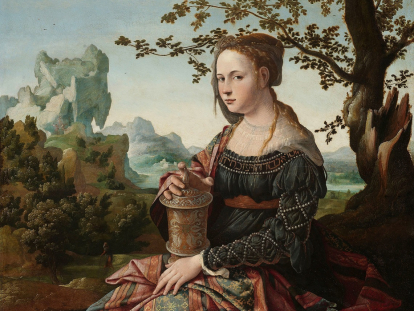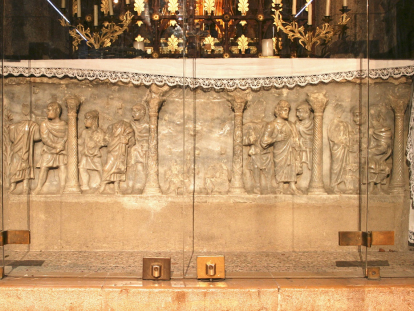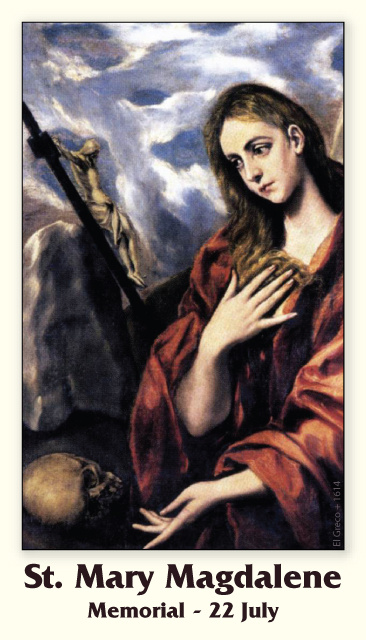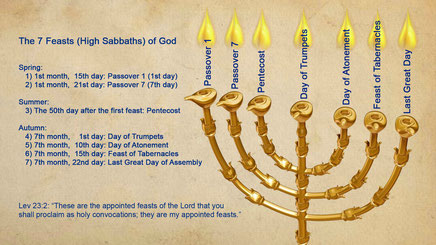|
|
General: MARY MAGDALENE ENDED HER DAYS IN EPHESUS WITH SAINT JOHN AND THE HOLY VIRGIN?
Elegir otro panel de mensajes |
|
|
It is said that if you want to see the relics of Mary Magdalene, you must travel to the church of Vézelay in Provence, France. These objects have been extremely controversial, as they are surrounded by legends and contradictory stories.
Some say that Mary Magdalene ended her days in Ephesus with Saint John and the Holy Virgin, while others say her relics were removed from there to Constantinople.
Another legend associates France with Mary Magdalene. That is if she escaped, along with Lazarus and his sisters, from persecution, reaching the coasts of Gaul. Mary Magdalene evangelized parts of France and spent her last days living in a cave in Provence. Her relics were first venerated in Vézelay.
Later, St Maximin-la Sainte Baume claimed that her relics were there and what is supposed to be her skull could be seen in the Basilica of St Maximin.
The skull of Mary Magdalene rests most of the year in the crypt of the Sainte Marie Madeleine Basilica, a Gothic basilica whose construction began in 1295 under Charles II of Anjou, King of Naples, Count of Provence and nephew of Saint Louis (King of France).
Mary Magdalene’s body was buried on this land, and then hidden for centuries only to be rediscovered on December 10, 1279 during excavations ordered by Charles II himself.
Mary Magdalene’s remains were found intact, except for her jawbone. Beneath the dust inside the tomb was a wax-wrapped wooden tablet. Mary Magdalene’s jawbone was sent to Rome after a previous excavation of her tomb and before the invasion of 710 AD, when all the important relics in France were hidden.

In Rome, Mary Magdalene’s jawbone had been venerated for centuries. With the news of the 1279 discovery, Pope Boniface VIII returned the jawbone to St. Maximin-la-Sainte-Baume and on April 6, 1295, it was reunited with Mary Magdalene’s skull.
It is said that, when Mary Magdalene’s tomb was first opened in 1279, there was a wonderful smell of roses that filled the air, and there was a small piece of skin attached to her skull, where Jesus touched her after his resurrection. The bishops who witnessed the excavation called it “noli me tangere”, because they believed that, through the miracle of Jesus‘ touch, the skin was still alive. The caretakers of the relics carefully sealed the “noli me tangere” in a glass vase.
In the seventeenth century, Protestants destroyed the Benedictine abbey of Vézelay, converted the church into a stable, and destroyed the relics. In 1793, during the French Revolution, the sanctuary was attacked and the relics thrown away. The St. Maximin Basilica was saved from total destruction by turning it into a government store.
Joseph Bastide, sacristan of St. Maximin, removed the skull of Mary Magdalene and the “noli me tangere”. After the Revolution, Bastide brought his treasure to the archbishop. The relics of Mary Magdalene, which are there now, were delivered to the church after its restoration.
Less than a century later, at the time when the gold reliquary was created to house the skull with its golden hair, carried by four golden angels (presumably 1860 because the Roman numerals “MDCCCLX” are on the back), the artist designed a special place under the skull to put the glass jar containing the precious “noli me tangere”.
Currently, believers and tourists can find the skull of Mary Magdalene in the crypt behind an iron grille beneath the ground floor of the basilica, down a narrow stone staircase just behind her alabaster sarcophagus. It is difficult to see the skull through the iron grille, even when close.
From July 22nd, for a whole week, the skull is taken out of this place with all the care, when the festival of Mary Magdalene begins. Mary Magdalene’s skull in its gold reliquary weighs approximately 400 kilograms and is carried by eight men from the basilica through the streets of St. Maximin-la-Sainte-Baume in a candlelit procession with songs and prayers. When they take Mary Magdalene’s skull outdoors, they cover it with a golden cloak to protect it.
After 2,000 years, the supposed skull of Mary Magdalene is preserved in a small town in the south of France, for everyone to see. Many witnesses claim that the characteristic scent of roses still lingers. However, it is impossible to confirm the origin of the bones of these relics, but the skull continues to be a precious treasure for Catholic believers.
https://culturacolectiva.com/en/history/mary-magdalene-skull-scent-roses/ |
|
|
|
|
 (photo: Via Wikimedia Commons)
In the year AD 250, seven young Christian men fled the persecution of the Roman Emperor Decius, taking shelter in a cave outside the city of Ephesus. There in the cave, the men prayed and eventually fell asleep; and Decius, seeing that they had refused to abandon their Christian faith and embrace his pagan beliefs, ordered that the mouth of the cave be sealed with the men still inside.
Decius died just a year later; and during the years that followed, Christianity found gradual acceptance in the Roman Empire. By the time of the Emperor Theodosius II (AD 408-450), Christianity had become the official state religion.
One day, the story goes, the landowner decided to open the mouth of the cave, in order to use it as a cattle pen. He opened it and found the men inside—still sleeping. As light streamed into the cave for the first time in nearly two hundred years, the men awoke. Confused, they at first believed that they'd been sleeping just one night. But when one of the men left the cave in search of food, he found that Christianity was no longer a persecuted religion in Ephesus. In fact, most people now shared his belief in Jesus Christ, and there were crosses openly displayed atop buildings in the town.
The townspeople, surprised by this group of young strangers who still carried coins from the ancient Decius era, told Marinus, the bishop, about them. Marinus interviewed the sleepers, and all recounted the same story of seeking refuge in the cave. Then, singing praises to God, the men died.
* * * * * * *
The legend of the Seven Sleepers has been told in many cultures, with some small variations, and has been depicted in art throughout the centuries.
- On the Eastern Orthodox and Byzantine Rite calendar, the Seven Holy Youths (Holy Sleepers) are remembered each August 4, and their names are listed: Maximilian, Jamblicus, Martinian, John, Dionysius, Exacustodian (Constantine), and Antoninus.
- In Islam, the Muslim Qur'an (Surah 18, verse 9-26) recounts a similar story—although in the Muslim version, the men had a dog who accompanied them to the cave, and who stood guard at the door for the entire time they were asleep. Muslims refer to the men as “People of the Cave.” Muhammad explains the story to his followers and is thus granted the status of being a prophet.
- In The Golden Legend, a popular book of the late Middle Ages, the writer adds a new detail: that their resurrection occurred in the year 378, during the reign of Theodosius.
- In the Roman Martyrology, the Seven Sleepers are mentioned on July 27, as follows: “Commemoration of the seven Holy Sleepers of Ephesus, who, it is recounted, after undergoing martyrdom, rest in peace, awaiting the day of resurrection.”
On the slopes of Mount Pion, near the ancient city of Ephesus, a popular pilgrimage site is an early Christian catacomb over which a 5th century church had been constructed. When the catacomb was first excavated in 1927-28, archeologists found inscriptions dedicated to the Seven Sleepers on the walls of the church and in the graves. And during the Crusades, victorious troops transported bones from the graves, identified as relics from the Seven Sleepers, back with them to Marseilles in a large stone coffin.
The Seven Sleepers have found their way into literature: in the poety of John Donne, in a 1530s play by John Heywood, in a poem by Goethe, in Washington Irving's “Rip Van Winkle,” in H.G. Wells' “The Sleeper Awakes,” and many other works.
The Seven Sleepers are sometimes compared to Rip Van Winkle; but no—the story is really dramatically different. In the case of Washington Irving's legendary character from the time of the Revolutionary War, most analysts seem to regard Rip as a man who was wasting his life away, letting the world pass him by while he merely existed in a bad marriage, without attempting to right what was wrong in his daily life. In sharp contrast, the Seven Sleepers were brave and righteous men who had turned their hearts and minds to God; and their heavenly Creator protected them from the fury of a pagan king, holding their lives in suspended animation for nearly two hundred years.
But is the story true? I don't know, but does that really matter?
The takeaway for the Christian reader is that God will always protect us, that we may face opponents but we need not fear, for God is with us.
|
|
|
|
|
Según se cuenta en los evangelios, María Magdalena fue discípula de Jesucristo y se unió a las mujeres que lo seguían después de ser liberada de los demonios. También se afirma que presenció la crucifixión y el enterramiento de Cristo, y que fue, además, la primera testigo de su resurrección.
Como sucede con otras figuras del ámbito bíblico, la existencia real de María Magdalena continúa siendo un misterio. ¿Quién era, en realidad? ¿Qué dicen las fuentes de su vida después del ajusticiamiento de Cristo? ¿Se sabe dónde se encuentra su tumba?
La historia real de María Magdalena, un tema debatido
Scorel María MagdalenaJan van Scorel,
La Magdalena no solo recibe culto en distintas iglesias del cristianismo, sino que también ha sido objeto de teorías que se mueven entre lo probable, lo pseudocientífico y lo sensacionalista. Ha llegado a afirmarse que María Magdalena habría sido la esposa de Jesucristo, con el que habría tenido dos hijos.
Dentro de esta amalgama de ideas y suposiciones, la imagen que pervive de María Magdalena la presenta como prostituta reformada y pecadora arrepentida. Esta noción, sin embargo, no está presente en la Biblia. Se trata de una construcción medieval que identifica a la figura femenina anónima que lava los pies de Jesús con lágrimas y los seca con sus cabellos, mencionada en el evangelio de Lucas, con María Magdalena.
La figura del pecador arrepentido cobra gran relevancia religiosa en Europa a partir del siglo XIII, sobre todo en el área itálica y entre las órdenes mendicantes franciscanas. El mensaje de que es posible obtener la salvación a través de la penitencia encuentra en la persona de la Magdalena un ejemplo perfecto. A partir de este momento, la discípula se incorpora en el repertorio iconográfico del duelo y el lamento. Se transforma en una de las figuras preeminentes que acompaña a Cristo durante la crucifixión.
Aparte de las evidencias en los evangelios y de las reelaboraciones teológicas posteriores en torno a su figura, se cuentan con pocos datos sobre su vida en las fuentes escritas. Uno de los textos que aporta información es el Synaxarion de Constantinopla. Además de recoger los testimonios que dan los evangelios sobre su figura, también apunta que, tras la muerte y la ascensión de Jesús, María Magdalena se trasladó a Éfeso junto a Juan Bautista. Fue allí, en la ciudad de la costa mediterránea, donde se afirma que murió. Según el Synaxarion, su cuerpo se enterró en la entrada de la cueva de los Siete Durmientes.
Durante el reinado del emperador bizantino León VI (886-912), las reliquias de María Magdalena se trasladaron a Constantinopla y se depositaron en el monasterio de San Lázaro junto a los restos sacros del santo homónimo. Desde allí, algunos fragmentos del cuerpo de la santa llegaron a Inglaterra y los territorios germanos como parte de las dotes de algunas princesas bizantinas que contrajeron matrimonio. A partir de este momento, el culto de María Magdalena comenzó a ganar cierta importancia en Bizancio y acabaría por popularizarse durante las cruzadas.
Otras leyendas medievales sostienen que María Magdalena habría huido, junto a Lázaro, Marta y otros discípulos, hacia occidente europeo hasta llegar a Francia. Instalada en suelo franco, habría predicado las doctrinas de Cristo.
Las tumbas de María Magdalena
Sarcófago María MagdalenaSarcófago de María Magdalena en Saint-Maximin. Imagen: Wikicommons
El cuerpo de María Magdalena no reposa en un único lugar, sino que sus restos se distribuyen entre varios centros religiosos, desde la cripta de Vézelay y el monasterio de Saint-Maximin hasta Magdala, la localidad de la que la Magdalena era oriunda.
En la primera mitad del siglo XI, el monasterio benedictino de Vézelay, en Borgoña, afirmó poseer las reliquias de la santa, que se expusieron públicamente para reverencia de los fieles. Muy pronto, comenzaron a producirse milagros y las peregrinaciones se multiplicaron. Éfeso era, entonces, un importante lugar de culto de la Magdalena, donde, en teoría, reposaban los restos de la santa.
Para justificar la presencia de las reliquias en Vézelay, los monjes benedictinos pusieron en circulación la historia de que Badilon, un monje, le habría arrebatado el cuerpo a los sarracenos en el año 749 y lo habría llevado hasta Borgoña, a la abadía de Vézelay, hoy basílica de Santa María Magdalena. En 1058, el papa Esteban IX declaró la autenticidad de las reliquias.
Dos siglos después, en 1279, los frailes dominicanos de Saint-Maximin descubrían en la cripta de la iglesia el que parecía ser el verdadero cuerpo de María Magdalena. El príncipe Carlos de Anjou había ordenado realizar excavaciones en la cripta de la iglesia después de haber tenido una visión. Por si hubiese dudas sobre la identidad de la difunta, testimonios de la época como el inquisidor Bernard Gui afirmaron que el cuerpo iba acompañado por una etiqueta con el nombre de la santa. Actualmente, en la cripta de Saint-Maximin todavía puede verse el cráneo entero de la santa preservado en un recipiente de vidrio transparente.
Otros restos de la santa se encuentran distribuidos en muchos otros templos y capillas. San Juan de los Florentinos, en Roma, alberga fragmentos óseos del pie izquierdo, por ejemplo, mientras que otros centros afirman poseer mechones de pelo y dedos que se dicen de la Magdalena.
Referencias
Chilton, B. 2010. Trois tombes de Marie Madeleine. Museum International, 62(2-3): 89-93. DOI: https://doi.org/10.1111/j.1755-5825.2010.01088
Foskolou, V. A. 2011-2012. Mary Magdalene between East and West: Cult and Image, Relics and Politics in the Late Thirteenth-Century Eastern Mediterranean. Dumbarton Oaks Papers Dumbarton Oaks Papers, 65/66: 271-296.
Gross-Diaz, T. 2019. The Cult of Mary Magdalene in the Medieval West, en E. F. Lupieri (ed.), Mary Magdalene from the New Testament to the New Age and Beyond, pp. 151–175. Leiden: Brill DOI: https://doi.org/10.1163/9789004411067_010
Saxer, V. 1955, L'origine des reliques de sainte Marie-Madeleine à Vézelay dans la tradition historiographique du Moyen-Âge. Revue des sciences religieuses, 29(1): 1-18.
https://www.muyinteresante.com/historia/36445.html |
|
|
|
|
MARIA MAGDALENA IN EPHESUS
She is a female Apostle followed Jesus Christ. There are many speculations about her but she is one of the three Mary.
In some sources she is known as the sinful woman who washed Jesus Christ’s feet, in some Jesus Christ’s wife and in others a prostitute whose sins were forgiven by the Jesus Christ. She followed Jesus Christ all the time. Mary Magdalene is one of the few people who witnessed Crucifixion, after crucifixion and resurrection. In three Bibles it is written that she witnessed all of these happenings. She is the first person who saw Jesus Christ’s tomb is not in the cave. It is said that Jesus Christ said “she was an apostle sent to the apostles”. Magdalene name is added after her name. It is said that 7 demons came off after she was forgiven.
St. John brought both the Virgin Mary and Mary Magdalene to Ephesus. It is also said that she went to France from Ephesus. It is said that she died in Ephesus and was buried very close to Ephesus. She is remembered on the 22nd July.
Attributes: Alabaster box of oinment and red egg.
Patronage: Hairdresser,Perfumeries,glove maker.
We provide Ephesus Tours to both house of the Virgin Mary where she lived before she died, see the tomb of the Mary Magdalene and the Church of the Mother Mary.
https://www.magical-steps.com/maria-magdalena-in-ephesus-.html |
|
|
 Primer Primer
 Anterior
11 a 25 de 25
Siguiente Anterior
11 a 25 de 25
Siguiente
 Último
Último

|
|
| |
|
|
©2025 - Gabitos - Todos los derechos reservados | |
|
|



 (photo: Via Wikimedia Commons)
(photo: Via Wikimedia Commons)






































![Revelation 1:14 (lsv) - and His head and hairs [were] white, as if ...](https://img2.bibliaya.com/Bibleya/verse/revelation-1-14-lsv.jpg)






